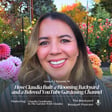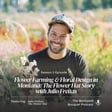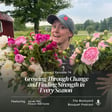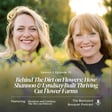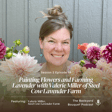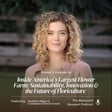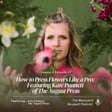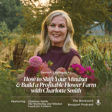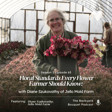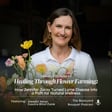Speaker
lately. Do you think it's possible to make a profit your first year as a flower farmer? Can someone just, because right now, especially in the Dahlia patch, my online community that I have, it's really awesome at our last Dahlia happy hour, two different ladies said that they were leaving their corporate jobs and starting a flower farm, which I applauded them for. And I think that's awesome. And they're forming an accountability group. But one of the questions I commonly hear when people make an announcement like that is, can I be profitable my first year? Is that a realistic expectation? Yeah. I would say, for the most part, plan on being profitable in year two or year three. Sure, you certainly can be profitable in your first year. I definitely was. I know a lot of farmers who were, but I don't think, I think it's a great question. I don't think it's that important of a goal. I think year and one, someone, one of my students recently said to me, oh, I'm in my R&D phase. And I was like, that's so smart to put it that way. You know what I mean? You're in your R&D phase. And I was thinking too, I heard this on a podcast recently that like big corporations or startups when they're just starting out, they consider their first few years R&D. They have huge losses. They're just figuring things out, but they know that's how it's going to go. Whereas farmers, I think we tend to beat ourselves up when we're not doing really well right away, which I think it's such a learning curve. You're not going to do well right away. But we all come from different places. Most of the people that I work with these days do own land. Maybe they're starting the farm in the backyard of the property they own, or maybe they have farmland already. That was not the case for me. I was leasing land. But I started out really, really scrappy. I was using hand-me-down tools. I didn't have any savings. I didn't have any money. I didn't have anyone giving me money or supporting my farm. I was just like making it work and living on very little money. You know, I think a lot of the people who are starting farms now are a little bit older than I was, probably have more assets, which makes their financial picture just more complicated. In some ways it means means great, they have the land to experiment on. But they also have real, you know, real complicated financial pictures with families and kids and mortgages and all these things. So I think really from the beginning, if you can focus on a few main things in order to get towards profitability, you know, I won't go deep into these right now. I'm sort of veering off course, but really thinking about the level of sales you're going to need to reach in order to get to profitability. You know, like if people are selling $15 mason jars that they worked for hours on to the local coffee shop, you know, I question what, many like how of those will you really need to do over time to even bring in the total sales you'll need to be able to put any money in your pocket? It's probably not going to... Basically, I think people need to be thinking bigger in terms of the sales they're going to need, not to mention how efficient they're going to have to be in order to make money off of those sales rather than have it all go out the window to expenses and to their time. But so really thinking about being ambitious with sales and working backwards from a sales goal, learning how to be fast and efficient on the farm, and really learning to dive into marketing from day one or day like negative one, if possible. Like you can be starting to market your flowers before you even have flowers. So yeah, I think sure you can be profitable in your first year, but let's set ourselves up to be profitable in year two or year three. That's really what I would encourage people to do. I think that's great advice. My other question related to that is there's such a diverse scale of flower farmers out there. There's everything from a backyard flower farmer now to someone that's growing on five or eight acres. Is there a magic size that you've seen to be profitable or can you be profitable at any scale? Ooh, great question. Again, you can certainly be profitable at any scale. I'll say that there are, you know, so many of the people that I work with these days are intending to keep their farm pretty small. And they don't know, you know, most people don't know how much space they're going to need. But certainly, if you're just doing this as kind of like a side hustle or a side job, I would recommend staying, imagining that you're going to stay under an acre, maybe well under an acre, because then, you know, you're really cultivating a local audience. You're growing on a small space. Some people are growing on only a quarter acre. And so you can't fit that many flowers on that size space, right? So you need to make sure you're getting top dollar for every single stem you do produce. And luckily, you get your highest prices with retail customer bases. So this is people out there in every corner of the country and the world starting to create local followings and local customer bases for their flowers. So obviously, this often happens with farm stands and CSAs and farmers markets and pops up, pops up, pops up. I like that. Pop-ups and that kind of thing. So, you know, there's a real solid model that can be achieved at growing like half an acre or so and selling to these retail customer bases. And I always like to encourage people to think through, and this kind of relates back to forecasting your sales and setting your sales goals. Like how many customers do you need? If you sell an average of like a $25 bouquet, if that's the main thing you sell, you probably don't need 20,000 customers every year. You need like, what is it? 100? Is it 500? And then if you build this customer base and really create a good relationship with them and you're kind of open and let them in behind the scenes of the farm and you speak to them and you understand their struggles, then you can probably find more things that they want from you. It's not just buying a bouquet one time. Maybe it's joining your subscription program. Maybe it's buying your winter wreaths as well. Maybe it's coming to a handful of workshops a year. So is there a way that you can build a customer base where each of these customers is investing pretty heavily in your farm? And that's really a worthwhile model. And I'll say that once people start creeping up towards like two acres, it, you know, it's a challenge. That's a real challenging size because you have too many flowers for a retail audience. In most cases, you're growing so much that you need to start selling wholesale, which means you need to drop the price. Maybe if you were selling a mixed bouquet for $25, let's say $30 for ease of numbers here, maybe you would only get $10 selling those same flowers wholesale. So you need to be growing a lot more. So you need more staff. Most of us hadn't managed teams before. Some people I work with certainly have, but not in a farm setting. So that's a challenge, learning how to be a manager. I think it's really worthwhile. I think everyone should kind of invest in some management training, even if you just have one person working for you and it's your neighbor's kid or something. But you need more equipment, you need more space, your expenses go up. So two acres is a bit of a challenging size, in my opinion. And then once you get up to three, four, five, up to 10 acres, that's where there's a real solid model of a production farm. You know, this is like, you know, some of these farms that I'll mention are bigger than that. But like Whipstone Farm and Raindrop Farm and Sunny Meadows and the Arnaskis in Texas, like all these farms that are that size and bigger, they are cranking out stems and selling them through a number of wholesale channels, most of them some retail as well. And that can really be a beautiful farm size. But you have a lot of expenses. There's often a lower profit margin. But you do find some stability there, especially as these farms scale up and hire in teams from out of the country, like H2A workers or, you know, but labor is challenging. So yeah, you know, I'll say that like, I really see two strong models. One, it's the like half acre ish size. Again, again, that can be a part time job or a-time job, depending on how much help you hire and how ambitious you are with your sales. And then jumping up to the production scale farm that's like three plus acres. Yeah, that's really good advice. One thing that I always, I think I had a misconception of going into flower farming is that I could manage a lot bigger space than I really could on my own. And I remember when I was starting out and when I went from, I went from a small plot in my front yard that was probably about 2000 square feet to a quarter acre. When I made the jump from a quarter acre to half an acre, I couldn't do it by myself because I was, well, at the time I was, I still struggle with perfectionism, but I was very much a perfectionist that I couldn't stand to have weeds in my field. So I, my first year made the mistake of spending so much money on labor for only weeding. And I realized that was not a profitable model either to follow. What is your advice? Like what's a manageable size for someone starting out or even that's five years in, what do you say is in a size if someone doesn't want to hire help? What's a good farm size? Yeah. You know, I love recommending a quarter acre and you and I both know that that's actually a ton of space. Like that A, you can grow tons of flowers on a quarter acre and B, that it's a lot to manage. It can be a lot to manage, as you said, especially if you don't, you know, if you're not fully on top of how to be quick and efficient with things like weeding and harvesting, which it just takes time. So in the first few years, you're not going to be quick or efficient. We had a really fun workshop at my farm a few weeks ago, and I don't do much in-person teaching anymore. During COVID, when I was teaching horticulture at a junior college, all the classes went online. So I've been teaching full-time pretty much ever since then, now with my own courses, of course, not through the junior college. So it was fun to teach in-person again. And what we really focused on during this one-day workshop, a morning workshop, was harvesting quickly, different ways of bunching, different ways of rubber banding, different ways of making bouquets quickly with pretty few ingredients, like three ingredients as a way to profitability. And it was such a great opportunity for people to get out there and focus on slowing down, learning the process. I was going to say doing the process the right way. There's of course a few ways to do everything, but learning my way and then speeding it up and seeing how much they could push themselves. Not that all of farming needs to always be a race, but there's these certain tasks that we do over and over and over and over every day, like weeding and harvesting. So you can't afford to be spending all your time doing that stuff. Yeah, I love recommending a quarter acre. And then if I'm really working with someone one-on-one or even in a group and they're very new, I'll actually say, you know what? I don't even think you should cultivate that whole quarter acre. Why don't we split it in half? You're going to cover crop half of it for a year and you're going to grow on the other half for a year. And I think that's a great rule of thumb, no matter the size. You know, I was working with a farmer last week who was taking on two acres and we decided to split it into four. And they were going to be growing cover crop on three quarters of that and then growing on the last quarter. You know, my fields, my farm has scaled up and scaled back down over the years. And in the end, you know, I had a few different fields and different towns. I was leasing a three acre plot. I was never growing on that full amount, more like one acre. But in the end, I had a peony field, which was a half acre and it wasn't even full. It was probably like, you know, more than half of the space, less than like, it was three quarters of half an acre. That's fun math for all of us. And then I had my little field behind my house, which was like a fifth of an acre. So really, I was growing crops on probably about a half acre altogether. And I was bringing in like $225,000 up to $250,000, which is really rare, I will say. And it was because of my background and it was because of all the business training I then went out and got a few years into my farm when I realized, ooh, how am I going to be able to work through this burnout? How am I going to be able to keep doing this? So I'd say that a lot of people are bringing



